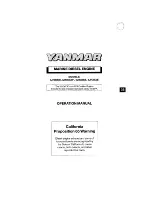
PERIODIC SERVICE
28
EN
GLISH
B
Changing coolant
1. To drain coolant, always open both drain shutoff-
valves and simultaneously open the radiator cap as
well. With the radiator cap kept closed, a complete
drain of water is impossible.
2. Remove the overflow pipe of the radiator pressure cap
to drain the recovery tank.
3. Prescribed coolant volume (U.S.gallons)
A
Coolant quantities shown are for standard radiators.
4. An improperly tightened radiator cap or a gap between
the cap and the seat quickens loss of coolant.
5. Coolant (Radiator cleaner and anti-freeze)
B
Remedies for quick decrease of coolant
1. Check any dust and dirt between the radiator fins and
tube. If any, remove them from the fins and the tube.
2. Check the tightness of the fan belt. If loose, tighten it
securely.
3. Check the internal blockage in the radiator hose. If
scale forms in the hose, clean with the scale inhibitor
or its equivalent.
B
Checking radiator hoses and clamp
bands
To avoid personal injury or death:
A
Be sure to check radiator hoses and
clamp bands periodically. If radiator
hose is damaged or coolant leaks,
overheats or severe burns could
occur.
Check to see if radiator hoses are properly fixed every
200 hours of operation or 6 months, whichever comes
first.
1. If hose clamps are loose or water leaks, tighten hose
clamp securely.
2. Replace hoses and tighten hose clamps securely, if
radiator hoses are swollen, hardened or cracked.
Replace hoses and hose clamps every 2 years or earlier,
if checked and found that hoses are swollen, hardened or
cracked.
B
Precaution at overheating
The event that the coolant temperature is nearly or more
than the boiling point is called
"OVERHEATING"
.
While running, make the following checks to see that all
parts are working correctly.
If anything is unusual,
inspect it, referring to the relevant description in
"MAINTENANCE" and "PERIODIC SERVICE" section
.
C
Coolant
If the coolant temperature warning lamp lights up or if
steam or coolant does not stop squirting from the radiator
overflow pipe, turn off the load and
keep the engine
idling (COOLING-DOWN) for at least 5 minutes
to let it
cool down gradually. Then stop the engine and take the
following inspection and servicing.
1. Check to see if the coolant runs short or if there is any
coolant leak;
2. Check to see if there is any obstacle around the
cooling air inlet or outlet;
3. Check to see if there is any dirt or dust between
radiator fins and tube;
4. Check to see if the fan belt is too loose; and
5. Check to see if radiator water pipe is clogged.
B
Cleaning radiator core (outside)
If dust is between the fin and tube, wash it away with
running water.
A
Do not clean radiator with firm tools such as spatulas
or screwdrivers. They may damage specified fin or
tube. It can cause coolant leaks or decrease cooling
performance.
Models
Quantity
WG1605-G-E3
WG1605-L-E3
WG1605-GL-E3
WG1605-N-E3
WG1605-LN-E3
4.0 L (1.06 U.S.gals.)
WG1903-G-E3
WG1903-L-E3
WG1903-GL-E3
WG1903-N-E3
WG1903-LN-E3
5.8 L (1.53 U.S.gals.)
WG2503-G-E3
WG2503-L-E3
WG2503-GL-E3
WG2503-N-E3
WG2503-LN-E3
8.4 L (2.22 U.S.gals.)
WG3800-G-E3
WG3800-L-E3
WG3800-GL-E3
WG3800-N-E3
WG3800-LN-E3
9.0 L (2.38 U.S.gals.)
Season
Coolant
All seasons
Pure water and anti-freeze
(See "Anti-freeze" in
“RADIATOR” section.)
EG523-8917_E.book Page 28 Friday, May 17, 2019 10:32 AM
















































